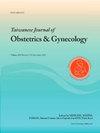腹腔镜骶骶固定术后下尿路症状及性功能的评价
IF 2.2
4区 医学
Q2 OBSTETRICS & GYNECOLOGY
引用次数: 0
摘要
目的探讨腹腔镜骶colpopexy (LSCP)治疗盆腔器官脱垂(POP)的疗效,特别是其对新生应激性尿失禁(SUI)发生率和性功能改变的影响。材料和方法本队列研究纳入了34名在2017年至2022年间接受LSCP治疗的3期和4期POP女性。基线和术后6个月的评估使用尿动力学研究和几种不同的失禁和脱垂问卷来评估LUTS、新生SUI、性功能和生活质量。随后,每6个月对患者进行膀胱日记和POP-Q量化系统评估。结果slscp显著改善了POP、尿频和SUI。尿失禁影响问卷(IIQ-7)、盆腔器官脱垂困扰问卷6 (POPDI-6)和盆腔器官脱垂/尿失禁性功能问卷(PISQ-12) 3个问卷均有显著进展。在34例患者中,16.7%(3/18)发生了新生SUI, 2.9%的患者术后出现阴道补片暴露。新发SUI的危险因素包括较高的BMI和术前SUI。LSCP有效缓解LUTS,尿频从平均每天14.7次减少到8.4次(P = 0.009),并显著改善脱垂症状和性功能,这反映在POPDI-6和PISQ-12评分中。结论slscp治疗POP疗效显著,可明显改善LUTS和性功能,且并发症发生率低。值得注意的是,BMI升高和术前SUI是发生新生SUI的重要危险因素。本文章由计算机程序翻译,如有差异,请以英文原文为准。
Evaluation of lower urinary tract symptoms and sexual function after laparoscopic sacrocolpopexy
Objective
This study aimed to investigate the effectiveness of laparoscopic sacrocolpopexy (LSCP) in the treatment of pelvic organ prolapse (POP), specifically its impact on the incidence of de novo stress urinary incontinence (SUI) and changes in sexual function.
Materials and methods
This cohort study involved 34 women with stage 3 and 4 POP who underwent LSCP between 2017 and 2022. Baseline and 6-month postoperative assessments were conducted using urodynamic studies and several various incontinence and prolapse questionnaires to assess LUTS, de novo SUI, sexual function, and quality of life. Subsequently, patients were evaluated every 6 months with bladder diaries and POP-Q quantification system assessment.
Results
LSCP led to significant improvements in POP, urinary frequency and SUI. Significant advancements were observed across 3 questionnaires: Incontinence Impact Questionnaire (IIQ-7), Pelvic Organ Prolapse Distress Inventory 6 (POPDI-6) and Pelvic Organ Prolapse/Urinary Incontinence Sexual Function Questionnaire (PISQ-12). Of the 34 patients, 16.7 % (3/18) experienced de novo SUI and 2.9 % developed vaginal mesh exposure postoperatively. Risk elements for de novo SUI included a higher BMI and preoperative SUI. LSCP effectively alleviated LUTS, reducing urinary frequency from an average of 14.7 to 8.4 episodes per day (P = 0.009), and significantly improved prolapse symptoms and sexual function, as reflected in POPDI-6 and PISQ-12 scores.
Conclusions
LSCP demonstrates high efficacy in the treatment of POP, significantly ameliorating LUTS and sexual function, while maintaining a low complication rate. Notably, elevated BMI and preoperative SUI emerge as significant risk elements for the development of de novo SUI.
求助全文
通过发布文献求助,成功后即可免费获取论文全文。
去求助
来源期刊

Taiwanese Journal of Obstetrics & Gynecology
OBSTETRICS & GYNECOLOGY-
CiteScore
3.60
自引率
23.80%
发文量
207
审稿时长
4-8 weeks
期刊介绍:
Taiwanese Journal of Obstetrics and Gynecology is a peer-reviewed journal and open access publishing editorials, reviews, original articles, short communications, case reports, research letters, correspondence and letters to the editor in the field of obstetrics and gynecology.
The aims of the journal are to:
1.Publish cutting-edge, innovative and topical research that addresses screening, diagnosis, management and care in women''s health
2.Deliver evidence-based information
3.Promote the sharing of clinical experience
4.Address women-related health promotion
The journal provides comprehensive coverage of topics in obstetrics & gynecology and women''s health including maternal-fetal medicine, reproductive endocrinology/infertility, and gynecologic oncology. Taiwan Association of Obstetrics and Gynecology.
 求助内容:
求助内容: 应助结果提醒方式:
应助结果提醒方式:


